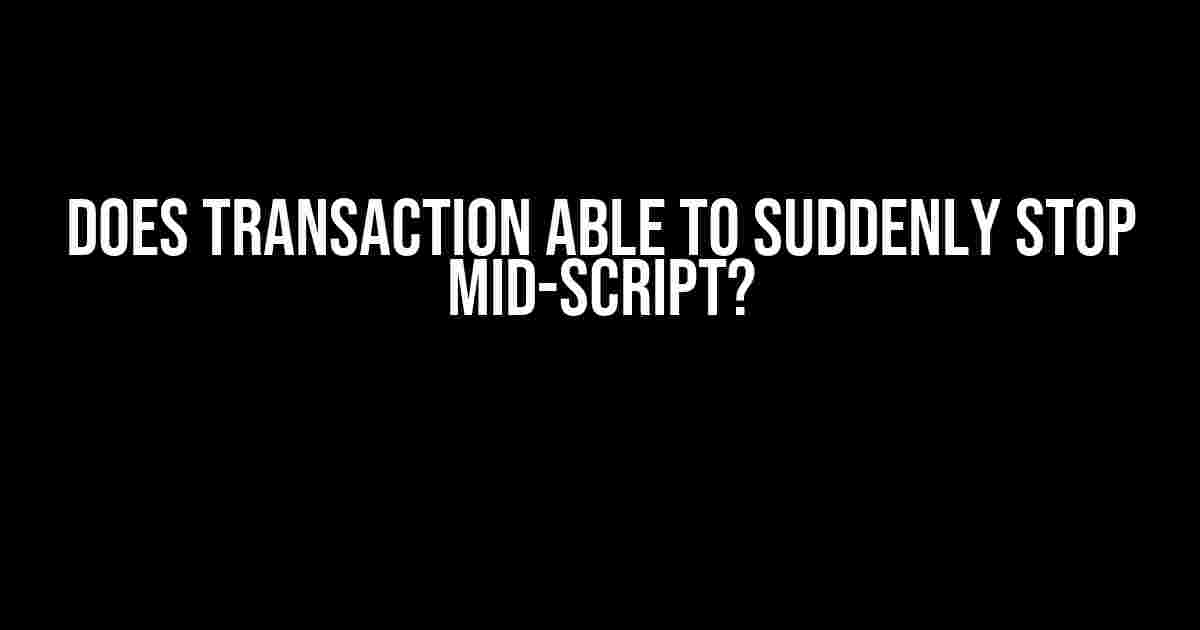Have you ever encountered a situation where your transaction suddenly stopped mid-script, leaving you wondering what went wrong? You’re not alone! In this article, we’ll delve into the world of transactions and explore the reasons behind this phenomenon. Buckle up, folks, as we dive into the details!
The Concept of Transactions
A transaction, in the context of computer science, refers to a sequence of operations executed as a single, all-or-nothing unit of work. This means that either all the operations within the transaction are completed successfully, or none of them are, ensuring data consistency and integrity.
Atomicity, Consistency, Isolation, and Durability (ACID)
Transactions must adhere to the ACID principles to ensure reliable and robust data management. These principles guarantee that:
- Atomicity: The transaction is treated as a single, indivisible unit of work.
- Consistency: The transaction maintains data consistency, ensuring that the data remains in a valid state.
- Isolation: The transaction executes independently, without interference from other transactions.
- Durability: Once the transaction is committed, its effects are permanent and cannot be rolled back.
Why Do Transactions Stop Mid-Script?
Now that we’ve covered the basics of transactions, let’s explore the reasons behind sudden stops mid-script:
1. Resource Constraints
In some cases, the system may run out of resources, such as memory, CPU, or I/O capacity, causing the transaction to abort. This can happen when:
- The system is overloaded with concurrent transactions.
- The transaction itself is resource-intensive.
- The underlying hardware or infrastructure is underpowered.
To mitigate this, ensure that your system is properly scaled and load-balanced, and that your transactions are optimized for resource efficiency.
2. Deadlocks and Livelocks
A deadlock occurs when two or more transactions are blocked, waiting for each other to release resources. A livelock, on the other hand, is a situation where two or more transactions are continuously retrying to execute, but cannot make progress due to conflicts.
These scenarios can cause transactions to stop mid-script. To avoid deadlocks and livelocks:
- Implement locks with timeouts to prevent infinite waits.
- Use multiversion concurrency control to allow concurrent access to data.
- Design transactions to avoid resource conflicts.
3. Errors and Exceptions
Syntax errors, runtime errors, or unexpected exceptions can cause transactions to fail mid-script. To handle errors and exceptions:
TRY {
// transaction code
} CATCH (Exception e) {
// error handling code
} FINALLY {
// cleanup code
}Use structured error handling mechanisms, such as try-catch-finally blocks, to gracefully handle errors and ensure transaction consistency.
4. External Factors
External factors, such as network failures, power outages, or hardware malfunctions, can cause transactions to stop abruptly. To minimize the impact of external factors:
- Implement redundancy and failover mechanisms.
- Use transactional logging and journaling to ensure data consistency.
- Design transactions to be idempotent, allowing for safe retries.
While we cannot eliminate external factors entirely, we can design our transactions and systems to be more resilient and fault-tolerant.
Best Practices for Transaction Management
To minimize the likelihood of transactions stopping mid-script, follow these best practices:
| Best Practice | Description |
|---|---|
| Use transactional boundaries | Clearly define the start and end points of transactions. |
| Implement logging and auditing | Log transactional events for debugging and auditing purposes. |
| Optimize resource usage | Minimize resource consumption and optimize transactions for performance. |
| Use retry mechanisms | Implement retry logic to handle temporary errors and exceptions. |
| Test and simulate failures | Thoroughly test transactions and simulate failure scenarios to identify vulnerabilities. |
By following these best practices, you can ensure that your transactions are robust, reliable, and less prone to sudden stops mid-script.
Conclusion
In conclusion, transactions can stop mid-script due to various reasons, including resource constraints, deadlocks, livelocks, errors, and external factors. By understanding the root causes and implementing best practices for transaction management, you can minimize the likelihood of sudden stops and ensure data consistency and integrity.
Remember, a well-designed transactional system is essential for maintaining data reliability and ensuring business continuity. So, take control of your transactions today and avoid the pitfalls of mid-script stops!
Bonus Tip: When debugging transactions, remember to inspect the transaction logs and error messages to identify the root cause of the issue. This will help you pinpoint the problem and take corrective action to prevent future occurrences.
Frequently Asked Question
Get the scoop on transaction interruptions and what you need to know!
Can a transaction really stop mid-script?
Yes, unfortunately, it’s possible. If the system detects an issue or anomaly during the transaction, it may abruptly stop the process to prevent any potential errors or losses.
What kind of issues can cause a transaction to stop mid-script?
A variety of factors can contribute to a transaction stopping mid-script, including network connectivity problems, system overload, incorrect input, or even a sudden power outage. The good news is that these issues are usually temporary and can be resolved quickly!
Will I lose my data if a transaction stops mid-script?
Don’t worry! In most cases, your data is safe and preserved, even if the transaction stops mid-script. The system will typically revert to a safe state, ensuring that your data remains intact and secure.
Can I resume the transaction where I left off?
In many cases, yes! Depending on the system and the type of transaction, you might be able to resume where you left off or restart the process from the beginning. Just check with the system administrator or support team for guidance specific to your situation.
How can I prevent transactions from stopping mid-script?
To minimize the risk of transactions stopping mid-script, make sure you’re working with a stable and reliable system, use strong and unique passwords, and keep your software and security protocols up to date. Additionally, it’s a good idea to regularly back up your data and have a plan in place for unexpected events.



